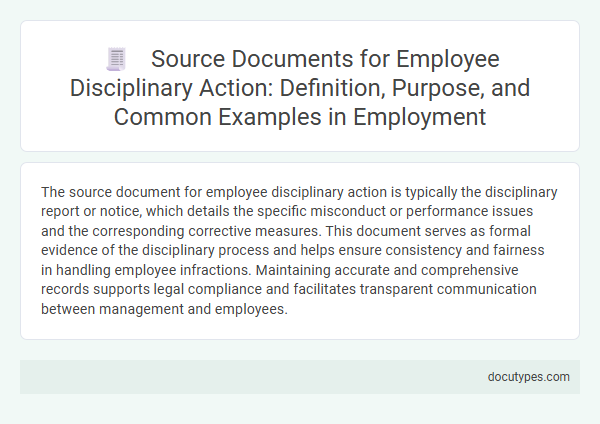The source document for employee disciplinary action is typically the disciplinary report or notice, which details the specific misconduct or performance issues and the corresponding corrective measures. This document serves as formal evidence of the disciplinary process and helps ensure consistency and fairness in handling employee infractions. Maintaining accurate and comprehensive records supports legal compliance and facilitates transparent communication between management and employees.
Introduction to Source Documents in Employee Discipline
Source documents for employee disciplinary action serve as official records that detail incidents and the steps taken in response. These documents are essential for maintaining transparency and consistency in the disciplinary process.
Introduction to source documents in employee discipline highlights their role in supporting fair treatment and legal compliance. Your ability to accurately document incidents helps protect both the employer and the employee throughout disciplinary proceedings.
Defining Source Documents for Disciplinary Action
Source documents for employee disciplinary action serve as the foundational records that detail the specifics of an employee's misconduct and the resulting disciplinary measures. These documents are essential for ensuring transparency, fairness, and legal compliance within the employment process.
- Incident Report - A formal record documenting the details of the employee's behavior or violation leading to disciplinary action.
- Warning Letter - An official written notice issued to the employee outlining the misconduct and potential consequences.
- Investigation Report - A comprehensive summary of the facts gathered during the inquiry into the alleged disciplinary issue.
Importance and Purpose of Disciplinary Source Documents
The source document for employee disciplinary action is a formal record detailing the specific misconduct or policy violation. It serves as concrete evidence for the disciplinary process within the workplace.
Disciplinary source documents are crucial for maintaining transparency and consistency in handling employee issues. They protect the organization legally by providing a clear account of actions taken in response to misconduct. These documents also help managers track patterns of behavior, ensuring fair treatment and supporting performance improvement efforts.
Key Elements of Effective Disciplinary Documentation
The source document for employee disciplinary action is typically a formal written record detailing the specific incident or behavior warranting correction. This document serves as the foundational evidence for any subsequent actions taken by human resources or management.
Key elements of effective disciplinary documentation include a clear description of the violation, dates, and names of involved parties. It must also outline previous warnings, the consequences imposed, and employee responses to ensure transparency and legal compliance.
Common Types of Source Documents in Employee Discipline
The source document for employee disciplinary action is a formal record that captures the details of an incident or behavior requiring corrective measures. It serves as the foundation for tracking disciplinary history and ensuring consistent enforcement of workplace policies.
Common types of source documents in employee discipline include:
- Written Warning - A document outlining specific infractions and expectations for improvement.
- Incident Report - A detailed account of an event or behavior leading to disciplinary action.
- Performance Improvement Plan (PIP) - A structured plan to address and correct performance issues over a defined period.
Examples of Disciplinary Source Documents in Practice
| Disciplinary Source Document | Description | Common Examples |
|---|---|---|
| Written Warning | Official record issued to an employee detailing specific misconduct or performance issues, serving as formal notice to improve behavior or work quality. | Warning letters, performance improvement plans (PIP), documented emails outlining issues |
| Incident Report | Detailed account of an event involving employee misconduct or policy violation, compiled by supervisors or witnesses to establish facts and context. | Accident reports, harassment complaint forms, attendance violation records |
| Investigation Report | Summary and findings from an internal inquiry into alleged employee misconduct, including statements, evidence, and conclusions supporting disciplinary actions. | HR investigation summaries, witness interviews, review of surveillance footage |
| Disciplinary Meeting Minutes | Documentation of discussions held during disciplinary hearings or meetings, capturing employee responses and decisions made. | Meeting notes, signed disciplinary summaries, corrective action agreements |
| Performance Reviews | Periodic evaluations assessing employee job performance, often used to identify ongoing issues that may lead to disciplinary measures. | Annual appraisals, mid-year reviews noting behavioral concerns |
| Attendance Records | Logs capturing employee punctuality and absences, which serve as evidence in discipline related to attendance policies. | Timecards, punch-in/out logs, absence reports |
These documents form the foundation of disciplinary action processes, ensuring clarity and fairness when addressing employee conduct. You must maintain accurate and organized records to support any corrective measures.
Legal Implications of Maintaining Accurate Source Documents
The source document for employee disciplinary action typically includes written records such as warning letters, incident reports, or performance evaluations. Maintaining accurate source documents is crucial for protecting your organization from legal disputes and ensuring compliance with labor laws. Precise documentation serves as evidence in case of grievances, supporting fair and transparent disciplinary procedures.
Best Practices for Documenting Employee Disciplinary Actions
The source document for employee disciplinary action is a formal record that details the infraction, the response taken, and any corrective measures required. Proper documentation ensures transparency and legal protection for both the employer and employee.
- Clarity - The document must clearly describe the incident, including dates, times, and involved parties to avoid ambiguity.
- Objectivity - Use factual, non-emotional language to present the information precisely and without bias.
- Consistency - Follow company policies and standard templates to maintain uniformity across all disciplinary records.
Maintaining accurate source documentation supports fair disciplinary procedures and aids in resolving disputes effectively.
Challenges and Risks in Handling Disciplinary Source Documents
What is the source document for employee disciplinary action? The source document is typically a formal record that details the specific incident or behavior leading to disciplinary measures, such as incident reports or written warnings. Handling these documents presents challenges like maintaining confidentiality and ensuring accuracy to avoid legal risks.
What Is the Source Document for Employee Disciplinary Action? Infographic

